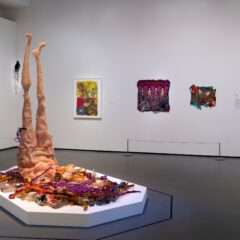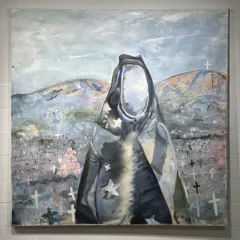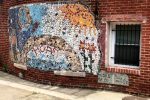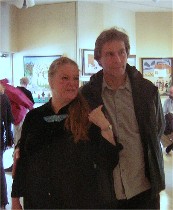 For months, fellow blogger Mark Barry has been trying to get us down to Baltimore for the American Museum of Visionary Art. Uhhh, it’s south. Uhhh, it’s a day’s commitment. Uhhh, we can’t get it together. Uhhh, we were so wrong.
For months, fellow blogger Mark Barry has been trying to get us down to Baltimore for the American Museum of Visionary Art. Uhhh, it’s south. Uhhh, it’s a day’s commitment. Uhhh, we can’t get it together. Uhhh, we were so wrong.
It was great.
Between Barry and museum director and visionary founder Rebecca Hoffberger (top image, Hoffberger left and Barry right), we got a warmer welcome than anything north of here can possibly muster. Here’s a picture of the fresh eggs from his very own chickens that Barry gave me (oh, yeah, he also gave Roberta her own eggs). Try to picture going to a New York museum and getting that kind of treatment.
Here’s a picture of the fresh eggs from his very own chickens that Barry gave me (oh, yeah, he also gave Roberta her own eggs). Try to picture going to a New York museum and getting that kind of treatment.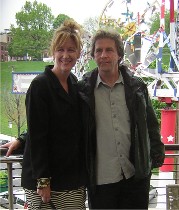 Besides, Barry brought along his wife, Sandra Magsamen, for lunch at the museum, with a swell view of the river that new condos across the street will soon obliterate (rumor has it Oprah may have bought one). Magsamen runs a business that started out from working with psychiatric patients and finding people had heartfelt things to say that they often didn’t say out loud. Check out her website, and she means every word she puts on her many products. Here’s a picture of the perfect couple.
Besides, Barry brought along his wife, Sandra Magsamen, for lunch at the museum, with a swell view of the river that new condos across the street will soon obliterate (rumor has it Oprah may have bought one). Magsamen runs a business that started out from working with psychiatric patients and finding people had heartfelt things to say that they often didn’t say out loud. Check out her website, and she means every word she puts on her many products. Here’s a picture of the perfect couple.
We got a tour of AVAM from Hoffberger, who has more energy than four walls can hold. But ultimately it was her life’s work–the art and the building itself–that swept us off our feet.
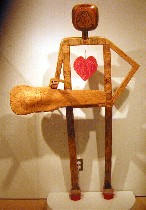 A mix of the fantastic and unlikely in the permanent collection include this wonderful man with violin case, all made out of toothpicks by artist Gerald Hawkes (left).
A mix of the fantastic and unlikely in the permanent collection include this wonderful man with violin case, all made out of toothpicks by artist Gerald Hawkes (left).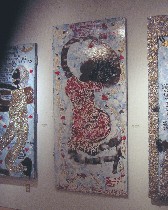 This exuberant image is by Mary L. Proctor (she calls herself Missionary Mary L. Proctor, and like a lot of these artists, she has a religious calling). Her vision has expanded to selling on line and out of the back of the family car. Here’s Proctor’s website.
This exuberant image is by Mary L. Proctor (she calls herself Missionary Mary L. Proctor, and like a lot of these artists, she has a religious calling). Her vision has expanded to selling on line and out of the back of the family car. Here’s Proctor’s website.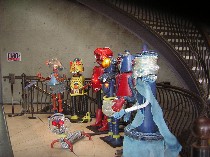 And this shot of DeVon Smith’s mechanical critters also shows the attention to detail in the building itself, with its beautiful, crafted railings. Smith’s work made me think about how different the intent was from Tom McCloskey (see my post here and Roberta’s here) and Alan Rath. There’s a delight here in the variety of looks, the reuse of vernacular materials, and the ways the figures glitter and move almost overwhelm the word messages. When the looks are so entrancing and entertaining, that’s plenty.
And this shot of DeVon Smith’s mechanical critters also shows the attention to detail in the building itself, with its beautiful, crafted railings. Smith’s work made me think about how different the intent was from Tom McCloskey (see my post here and Roberta’s here) and Alan Rath. There’s a delight here in the variety of looks, the reuse of vernacular materials, and the ways the figures glitter and move almost overwhelm the word messages. When the looks are so entrancing and entertaining, that’s plenty.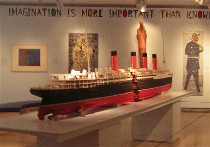 The work in the permanent that impressed our traveling companion, Alex, a high school student who was staying with Roberta last week, was this model of the Lusitania by Wayne Kusy, also made of toothpicks. The 16-foot long ship is made with 194,000 toothpicks and five gallons of glue. It took approximately two and a half years to construct, according to the Anatomically Correct website.
The work in the permanent that impressed our traveling companion, Alex, a high school student who was staying with Roberta last week, was this model of the Lusitania by Wayne Kusy, also made of toothpicks. The 16-foot long ship is made with 194,000 toothpicks and five gallons of glue. It took approximately two and a half years to construct, according to the Anatomically Correct website.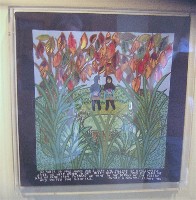 The exhibit that moved me to tears was “Tapestries of survival,” a series of 36 embroidery/collage pictures with narrative by Esther Nisenthal Krinitz that tell the tale of her families everyday lives in a Polish village interrupted by World War II. Of all the Jews in their village, only Krinitz and her sister survived the Holocaust. (from the picture: “October 30, 1942. …Instead we went to the depths of the forest and waited for nightfall.” embroider and fabric collage, 1994, 20 x 20 inches).
The exhibit that moved me to tears was “Tapestries of survival,” a series of 36 embroidery/collage pictures with narrative by Esther Nisenthal Krinitz that tell the tale of her families everyday lives in a Polish village interrupted by World War II. Of all the Jews in their village, only Krinitz and her sister survived the Holocaust. (from the picture: “October 30, 1942. …Instead we went to the depths of the forest and waited for nightfall.” embroider and fabric collage, 1994, 20 x 20 inches).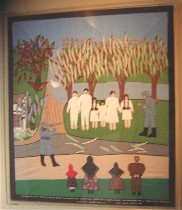 Krinitz, who was a dressmaker untrained in art, began the project at age 50 in 1977 to pass her memories on to her children. It took her 22 years to complete the story ( from the picture: “September 1942 …the Gestapo made a surprise raid and in our nightshirts, lines us up by the river and terrorized us with their guns as our Polish neighbors looked on,” embroidery and fabric collage, 1992, 36 x 38 inches).
Krinitz, who was a dressmaker untrained in art, began the project at age 50 in 1977 to pass her memories on to her children. It took her 22 years to complete the story ( from the picture: “September 1942 …the Gestapo made a surprise raid and in our nightshirts, lines us up by the river and terrorized us with their guns as our Polish neighbors looked on,” embroidery and fabric collage, 1992, 36 x 38 inches).
 The contrast of the beautiful, cheerful images with the horrors they depict gives this work its impact along with the complexity of each vision. The words and the pictures have the clear-eyed, unembroidered directness of herself as a child, witnessing awful things (from the picture: “September 1942. After the morning raid, the Gestapo were returning. We fled across the fields to the woods, my mother directing me to separate,” embroidery on cloth, 1992, 22 x 22 inches).
The contrast of the beautiful, cheerful images with the horrors they depict gives this work its impact along with the complexity of each vision. The words and the pictures have the clear-eyed, unembroidered directness of herself as a child, witnessing awful things (from the picture: “September 1942. After the morning raid, the Gestapo were returning. We fled across the fields to the woods, my mother directing me to separate,” embroidery on cloth, 1992, 22 x 22 inches).“Tapestries” will be there until August, and it’s reason enough to go to Baltimore.
The other terrific exhibit is “Holy H2O: Fluid Universe.” The range of work is great, including straightforward paintings, amazing beadwork, sculptures and models, just about every form of expression in art.
Among my faves were these:
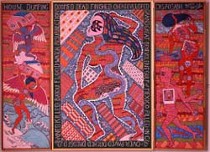 Steve Shepard has several complex paintings including this fabulous triptych, “Doomeddead.” His subject is water and pollution, and one of his paintings was inspired by a report that the Thames fish aren’t reproducing because the male fish are being rendered sterile by the hormones women who take birth control pills excrete.
Steve Shepard has several complex paintings including this fabulous triptych, “Doomeddead.” His subject is water and pollution, and one of his paintings was inspired by a report that the Thames fish aren’t reproducing because the male fish are being rendered sterile by the hormones women who take birth control pills excrete.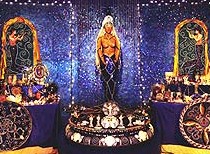 This is a detail from a mixed-media room installation–a beaded shrine to sirens by Nancy Josephson. Every inch of the walls are covered with glass beads (detail from “La Siren”).
This is a detail from a mixed-media room installation–a beaded shrine to sirens by Nancy Josephson. Every inch of the walls are covered with glass beads (detail from “La Siren”). Tom Duncan’s “Slave Ship” is a depiction of death in the Middle Passage, horrifying, thought-provoking and filled with details.
Tom Duncan’s “Slave Ship” is a depiction of death in the Middle Passage, horrifying, thought-provoking and filled with details.
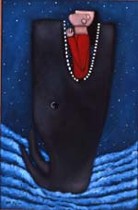 Here’s Rose Walton’s “Jonah and the Whale.”
Here’s Rose Walton’s “Jonah and the Whale.”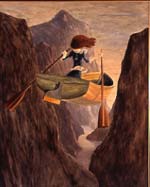 And here’s Mark Casey Milestone’s surreal oil on wood painting (“Untitled”).The program notes get into that space of weird science, where people mistake art thoughts for scientific thinking, but that doesn’t mean it’s not meaningful.
And here’s Mark Casey Milestone’s surreal oil on wood painting (“Untitled”).The program notes get into that space of weird science, where people mistake art thoughts for scientific thinking, but that doesn’t mean it’s not meaningful.
By the way, this place has a good gift shop, filled with real pieces made by individual artists.
Roberta will take the outsider story outside the four walls of the AVAM.
We also stopped at the Baltimore Art Museum, worth the visit for two exhibits–The Cone sisters’ collection of Impressionist art and lace and an exhibit of slide art, that suddenly passe practice whose time came and went in the blink of an eye. The slide show will be gone in a blink of an eye, too–May 15. Oh well. Among its highlights Jan Dibbets‘ two-wall view of land and sea (“Land/Sea”), and a room installation of projected windows by Krzysztof Wodiczko.


